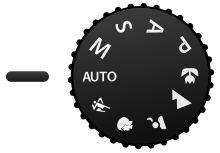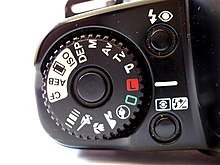
A single-lens reflex camera (SLR) is a camera that typically uses a mirror and prism system that permits the photographer to view through the lens and see exactly what will be captured. With twin lens reflex and rangefinder cameras, the viewed image could be significantly different from the final image. When the shutter button is pressed on most SLRs, the mirror flips out of the light path, allowing light to pass through to the light receptor and the image to be captured.

An autofocus optical system uses a sensor, a control system and a motor to focus on an automatically or manually selected point or area. An electronic rangefinder has a display instead of the motor; the adjustment of the optical system has to be done manually until indication. Autofocus methods are distinguished as active, passive or hybrid types.

The Nikon F6 is a 35 mm film single-lens reflex camera body manufactured by Nikon between 2004 and 2020. It is the sixth film camera in Nikon's line. The Nikon F6 was designed by Nikon and was manufactured at their Sendai plant.

The Nikon F-801 is a 35mm SLR released worldwide in June 1988 and manufactured until 1991, when it was replaced by the improved Nikon F-801s, which in turn was discontinued in early 1995. Although its autofocus mechanism is slow in comparison to modern standards, it was an improvement on Nikon's first attempt at an autofocus SLR - the F-501, and proved to be reliable and durable, typical of Nikon's cameras.

The Pentax Auto 110 and Pentax Auto 110 Super were fully automatic single-lens reflex cameras manufactured by Asahi Pentax for use with Kodak 110 film cartridges. The Auto 110 was introduced with three interchangeable, fixed focal length lenses in 1978. A further three lenses were added in 1981 to coincide with the release of the Auto 110 Super the following year. The camera system was sold until 1985. The complete system is sometimes known as the Pentax System 10, apparently for its official Pentax name, although most Pentax advertising only uses the camera name or Pentax-110. This model represented the only complete ultraminiature SLR system manufactured for the 110 film format, although several fixed-lens 110 SLRs were sold. The camera system also claims to be the smallest interchangeable-lens SLR system ever created.

The Nikon F-501 was the first successful autofocus SLR camera sold by the Nikon Corporation beginning in 1986. A nearly identical, albeit manual focus version, called the Nikon F-301 was also available. Subsequent models in the consumer line included the Nikon F-401, Nikon F-601, and Nikon F-801 / F-801s.

The EOS IX or EOS IX E is an APS-format single-lens reflex camera that was introduced by Canon Inc. of Japan in October 1996 as part of their EOS series SLR cameras. The other APS camera in this series is the Canon EOS IX Lite, also known as the EOS IX 7. Production ended in 2001.
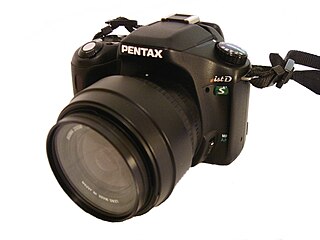
PENTAX *ist DS is a digital SLR camera produced by Pentax. The *ist DS produces a 6.1 megapixel resolution image. The *ist DS was a lower-prices follow-on to the Pentax *ist D. In September 2005 the Digital Imaging Websites Association (DIWA), a worldwide organization of collaborating websites, announced that Pentax had received their first DIWA Award for a DSLR camera. The *ist DS model was awarded with a Silver medal for outstanding test results.
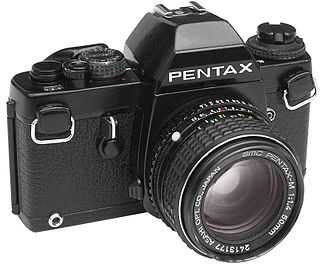
The Pentax LX is a 35 mm single-lens reflex camera produced by Pentax in Japan. It was introduced in 1980, to commemorate the 60th anniversary of Asahi Optical, and was produced until 2001. The LX uses the K mount which is the Pentax proprietary bayonet lens mount. It has manual and aperture priority automatic exposure modes. It is the top-of-the-line "professional" or "system" camera in the Pentax manual focus range, and has a large range of accessories. Compared with contemporary professional camera bodies from rival manufacturers, like the Canon New F-1 or Nikon F3, the LX body is smaller and lighter, weighing in at 570 grams with standard FA-1 finder.

The EOS-1N is a 35mm single lens reflex (SLR) camera body produced by Canon. It was announced by Canon in 1994, and was the professional model in the range, superseding the original EOS-1. The camera was itself superseded by the EOS-1v in 2000.
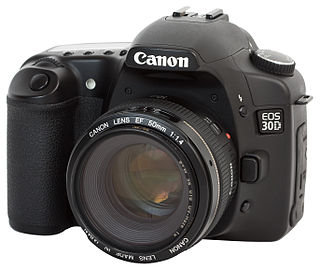
The Canon EOS 30D is an 8.2-megapixel semi-professional digital single-lens reflex camera, initially announced on February 21, 2006. It is the successor of the Canon EOS 20D, and is succeeded by the EOS 40D. It can accept EF and EF-S lenses, and like its predecessor, it uses an APS-C sized image sensor, so it does not require the larger imaging circle necessary for 35 mm film and 'full-frame' digital cameras.

Live preview is a feature that allows a digital camera's display screen to be used as a viewfinder. This provides a means of previewing framing and other exposure before taking the photograph. In most such cameras, the preview is generated by means of continuously and directly projecting the image formed by the lens onto the main image sensor. This in turn feeds the electronic screen with the live preview image. The electronic screen can be either a liquid crystal display (LCD) or an electronic viewfinder (EVF).

The Pentax ME F was an amateur level, interchangeable lens, 35 mm film, single-lens reflex (SLR) camera. It was manufactured by Asahi Optical Co., Ltd. of Japan from November 1981 to 1984. The ME F was a heavily modified version of the Pentax ME-Super, and a member of the Pentax M-series family of SLRs. It was the first mass-produced SLR camera to come with an autofocus system.

A mode dial or camera dial is a dial used on digital cameras to change the camera's mode. Most digital cameras, including dSLR and SLR-like cameras, support modes, selectable either by a rotary dial or from a menu. On point-and-shoot cameras which support modes a range of scene types is offered. On dSLR cameras and SLR-like cameras, mode dials usually offer access to manual settings. The more compact point-and-shoot cameras, and cameras offering a great many modes, do not have mode dials, using menus instead. Some SLR lenses themselves offer control over things such as aperture, reducing the need for mode support in the camera body.

The Konica Hexar is a 35 mm fixed-lens, fixed focal length autofocus camera which was produced through the 1990s. It was introduced to the market in 1993. While styled like a rangefinder camera, and intended for a similar style of photography, in specification it is more like a larger "point and shoot" camera.

The Canon EOS 100 is a 35 mm autofocus SLR camera introduced by Canon in 1991. It was marketed as the EOS Elan in North America. It was the second camera in the EOS range to be targeted at advanced amateur photographers, replacing the EOS 650.

The Minolta 9000 AF is a professional Single-lens reflex autofocus camera, introduced by Minolta in August 1985. It was both Minolta's and the world's first professional autofocus SLR. It was called Minolta Maxxum 9000 in the US and Minolta α-9000 in Japan.

The Nikon F-601m is a manual focus, autoexposure, auto film loading and advancing 35 mm SLR camera manufactured by the Nikon Corporation and released in 1990.
Sensitivity priority, often abbreviated Sv on a camera dial, and colloquially called "ISO priority", is a setting on Pentax cameras that allows the user to choose a specific Sensitivity value while the camera selects a shutter speed and aperture to match. The camera will ensure proper exposure. This is different from manual mode, where the user must decide all three values, shutter priority where the user picks a shutter speed with the camera selecting the aperture to match, or program mode where the camera selects all three.

Canon EOS 1100D is a 12.2-megapixel digital single-lens reflex camera announced by Canon on 7 February 2011. It is known as the EOS Kiss X50 in Japan and the EOS Rebel T3 in the Americas. The 1100D is Canon's most basic entry-level DSLR, and introduces movie mode to other entry level DSLRs. It replaced the 1000D and is also the only Canon EOS model currently in production that is not made in Japan but in Taiwan, aside from the EOS Rebel T4i.
